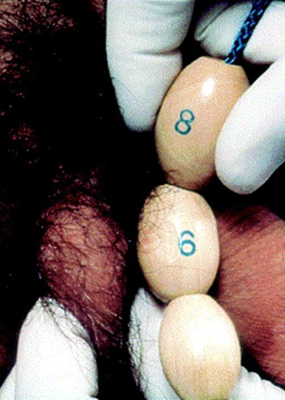Monitoring
All patients need to be monitored until the pubertal process is complete. Puberty is accompanied by the growth spurt and is typically complete within 2 to 5 years. Growth should be monitored on age- and sex-appropriate growth charts to ensure that the full growth potential is achieved. On average, puberty contributes 25 cm (10 inches) of height in females and 30 cm (12 inches) in males.
Continued pubertal assessment is best assessed by Tanner staging.[38][39] Stage 5 is adult for both sexes and indicates completion of the process. Testicular size is documented as a measurement of the longest axis or as the testicular volume using the Prader orchidometer.
[Figure caption and citation for the preceding image starts]: Prader orchidometerCreated by BMJ Knowledge Centre [Citation ends]. [Figure caption and citation for the preceding image starts]: Method of comparing testicular size using the Prader orchidometerFrom the collection of Dr A. Mehta; used with permission [Citation ends].
[Figure caption and citation for the preceding image starts]: Method of comparing testicular size using the Prader orchidometerFrom the collection of Dr A. Mehta; used with permission [Citation ends].
It is not always possible to clarify whether a patient has a permanent defect at initial testing prior to pubertal induction, as the clinical signs may be similar and - unless a clear loss-of-function mutation is identified - there is no definitive test to differentiate between hypogonadotropic hypogonadism and constitutional/ self-limited delay.[45] If the diagnosis of a permanent defect is in doubt, endocrine tests should be repeated after completion of growth and puberty to ascertain the need for long-term hormone replacement.[56]
Additional monitoring of patients with an underlying etiology of chromosomal syndromes, tumors, and autoimmune disorders will depend upon the individual condition.
Use of this content is subject to our disclaimer